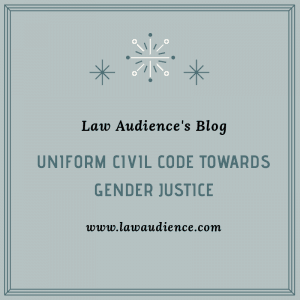AUTHORED BY: MR. AVINASH PANDEY, B.B.A.LL.B, 2ND YEAR STUDENT AT IFIM LAW COLLEGE & RESEARCH WRITER AT LAW AUDIENCE & EDITED BY: MS. PRIYA KUSHWAH, B.A.LL.B, STUDENT AT NATIONAL UNIVERSITY OF STUDY AND RESEARCH IN LAW, RANCHI & ASSISTANT EDITOR AT LAW AUDIENCE.
I. INTRODUCTION:
An article of Association is a charter which guides the laws and bye-laws for the comprehensive administration of the corporation and for the accomplishment of its objective as stated in the memorandum of membership of the organization. It is a document of predominant importance in the growth of an organisation as it carries the guidance for the inner administration of the company’s businesses. The articles of association are ancillary to the epistle of association of the company. They define the powers, functions, endowments of the management of a company as among themselves and the company at huge. Further, they also designate the method and form in which modifications in the internal administration of a company may be established from time to time.
Keyword: Charter, Bye-laws, Epistle, Ancillary.
II, PROVISION OF THE AOA UNDER THE COMPANIES ACT:
[1]Chapter 2, Sec 5 of the Companies act 2013:
- The articles of a company shall include the statutes for the administration of the corporation.
- The articles shall also include such subjects, as may be prescribed: Granted that nothing prescribed in this subsection shall be assumed to preclude an organisation from carrying such supplementary topics in its articles as may be supposed important for its administration.
- The sections may comprise provisions for entrenchment to the effect that detailed provisions of the articles may be modified only if circumstances or methods as that are more qualificator than those suitable in the case of an extraordinary resolution, are answered or complied with.
- The articles for enrooting mentioned in sub-section {3} shall only be made either on the development of an association or by an alteration in the articles allowed to by all the divisions of the corporation in the case of an own organisation and by an exceptional resolution in the case of a state company.
- Where the provisions contain terms for entrenchment, whether made on the development or by reformation, the association shall give intimation to the Registrar of such articles in such structure and method as may be prescribed.
- An association may choose all or any of the controls included in the model articles appropriate to such a company.
- In matter of any company, which is enrolled after the initiation of this Act, in so far as the designated articles of such association do not prohibit or transform the regulations carried in the standard articles suitable to such company, those ordinances shall, so far as relevant by the regulations of that association in the likewise manner and to the amount as if they were included in the appropriately enrolled provisions of the company.
- Nothing in this division shall implement to the articles of an association recorded under any prior company act unless revised under this Act.
III. SOME LANDMARK JUDGEMENTS PERTAINING TO AOA:
In the case of Kinetic Engineering Ltd. v. Sadhana Gadia[2], the Company law board held that “if any provision of the articles or the memorandum is contrary to any provisions of any law, it will be invalid in toto”.
In the case of Naresh Chandra Sanyal v. Calcutta Stock Exchange Association Ltd[3] the apex court judged that “The articles observe the interior administration of the actions of the organisation by way of ascertaining the dominance of its officers and forming a compromise between the organisation and the members. This agreement dictates the ordinary rights and duties subsidiary to membership in the company”.
IV. INNARDS OF ARTICLES:
The articles set out the rules and regulations framed by the company for its own working. The articles should contain generally the following matters: [4]
- Separation wholly
- Approval of preceding deals.
- Quantity and amount of shares.
- Issuance of preference shares.
- Allocation of shares.
- Proposals on shares.
- Lien on shares.
- Transfer and synchromesh of shares.
- Nomination.
- Relinquishment of shares.
- Remodelling of capital.
- Buyback.
- Share certificates.
- Dematerialisation.
- Translation of shares into assets.
- Voting preferences and delegates.
- Conferences and rules concerning organisations.
- Directors, their appointment and delegations of powers.
- Nominee executives.
- Issuance of Debentures and stocks.
- Audit Commission.
- Operating Director, Whole-time Director, Administrator, Secretary.
- Supplementary directors.
- Seal.
- Payment of directors.
- Common meetings.
- Directors conferences.
- Borrowing powers.
- Returns and reserves.
- Records and audit.
- Winding up.
- Indemnity.
- Capitalisation of reserves.
V. CONCLUSION:
It is an established company law principle that the articles of association of a corporation cannot neglect the stipulations of the Companies Act, 2013. Moreover, the articles of association of a distinct organisation are also obliged to recognise the record of the memorandum of the association as the provisions are subordinate to the authorization which is the epistle of the organisation as well as any other company legislation in force at that time.
Thus, it is of basic importance that when a company is being consolidated, and the articles of association of the company are being generated, the same must be done in consonance with the epistle of the agreement, the Companies Act 2013 and any other company law which is in force at that time. The articles of association may include entrenchment provisions. However, this notion of entrenchment was not present in the Companies Act, 1956. The word entrench means to build an attitude, habit, or belief so firmly that development is extremely challenging or questionable. Thus, an entrenchment article is the one which addresses several amendments either inaccessible or difficult.
[1]www.advocatekhoj.com/library/bareacts/companies2013/5.php?Title=Companies%20Act,%202013&STitle=Articles (last visited on 29/11/2018).
[2]Kinetic Engineering Ltd. vs SadhanaGadia (1992) 1 Comp LJ 62 (CLB).
[3] Naresh Chandra Sanyal v. Calcutta Stock Exchange Association Ltd 1971 AIR 422.
[4]https://www.legalbites.in/article-of-association/ (Last visited on 04/12/2018).



